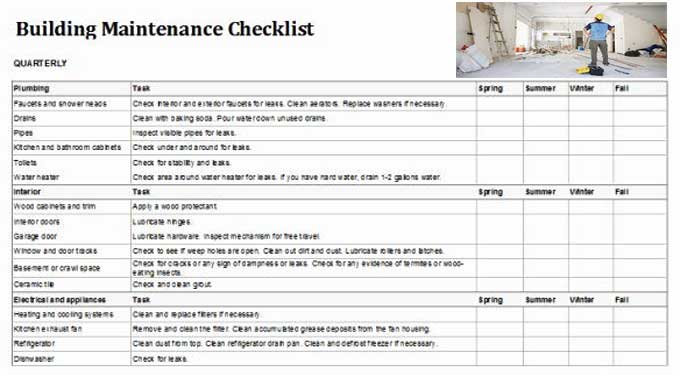
Building Maintenance Checklist: Everything you need to know
One of the most time-consuming and challenging stages of a project's whole life cycle is the maintenance of buildings and the parts that make them up. Maintenance procedures must be consistent and precise in order to guarantee that the building keeps operating at its maximum potential throughout time.
The team working on this phase will unavoidably utilize the building maintenance checklist in addition to facilities management software to plan, track, and monitor both normal and emergency maintenance actions.
Building Maintainance Checklist
All the maintenance tasks that need to be completed on the building and its components are included in a building maintenance checklist. It functions as a kind of calendar that enables facility managers and maintenance supervisors to make sure every maintenance task is completed accurately, on schedule, and without omitting anything.
Building maintenance teams must maintain many components that age due to repeated exposure to the elements, wear out due to repeated use, or simply cease to function due to technological limitations.
The building management checklist acts as an effective instrument to monitor the planning and execution of maintenance activities, specifically supporting the workers who are involved in building facility management.
Role in Construction
A building's lifetime performance depends on the proper maintenance, whether it be ordinary or extraordinary, throughout its lifecycle for it to function at its full potential and with the same efficiency as when it was designed and built.
In order to ensure the correct and efficient management and maintenance of an asset, it is therefore imperative to have a good building maintenance program implemented. A building maintenance program is an indispensable tool that you cannot do without.
Benefits of Building Maintainance Checklist
The advantages of preparing a maintenance plan and checklist are numerous, here are a few of the benefits:-
- reduces the need for repairs and equipment downtime;
- reduces the need for urgent interventions, which organizes and increases the productivity of management and maintenance staff;
- keeping the cost of special maintenance low;
- strengthens building security;
- increases the lifespan of installations and machinery.
Steps to create an ideal checklist
The steps to create an ideal checklist are as mentioned below:-
Step 1; Element inspection
Depending on the type of control and inspection, inspections may be conducted daily, weekly, monthly, quarterly, or annually. Nevertheless, the goal of this project is to make sure that all parts of the building are functioning as efficiently as possible and that they are durable as well.
Step 2; determining the difficulties
The execution of routine inspections enables the detection of impending problems and possible malfunctions. This should prevent the emergence of much more significant issues whose resolutions would be more difficult in terms of effort and expense.
Step 3; calculating the solution to the difficulties
Detecting potential problems early is vital to prevent them from becoming more serious and interfering with normal functioning.
Step 4; Proper executioning
The importance of prevention for the safe and efficient operation of the entire work and its installation systems throughout the life cycle of the project can be demonstrated by the adequate planning of inspections and controls.
Factors to consider while making the checklist
Building maintenance checklists must consider the following factors for a thorough assessment in order to guarantee the asset's right maintenance and functioning throughout its life cycle as well as the safety and well-being of building occupants:
Safety protocols
Keeping a well-maintained building in good condition is an important part of making sure it is safe for its occupants as well as having safety equipment inside. The purpose of this is to ensure that common hazards associated with buildings can be prevented or avoided as much as possible.
Interiors of the structure
The interior of a building must be carefully inspected on a regular basis by a methodical check and a random inspection to maintain its quality.
The building owner can proactively respond to any potential issues, and this, in turn, extends the life expectancy of the building, allowing it to be more serviceable for longer periods of time.
To get more details, watch the following video tutorial.
Video Source: Maintenance Manager HQ
Exterior
It is ideal to regularly check the building's exterior as well as its interior since it is always a good practice to keep track of both. By doing so, you can ensure that your facilities are in good operational condition and maintain their value for the long term.

Ventilation
Verify the ventilation, heating, and air-conditioning systems. Check that all safety controls, both indoor and outdoor, are working properly. Depending on the frequency of usage, clean or replace the air filters on a weekly or quarterly basis.
Check the condensate collecting pan, oil, and coolant levels. Examine compressed air lines, pipework, and insulation, and look for leaks around fittings and pipes.

